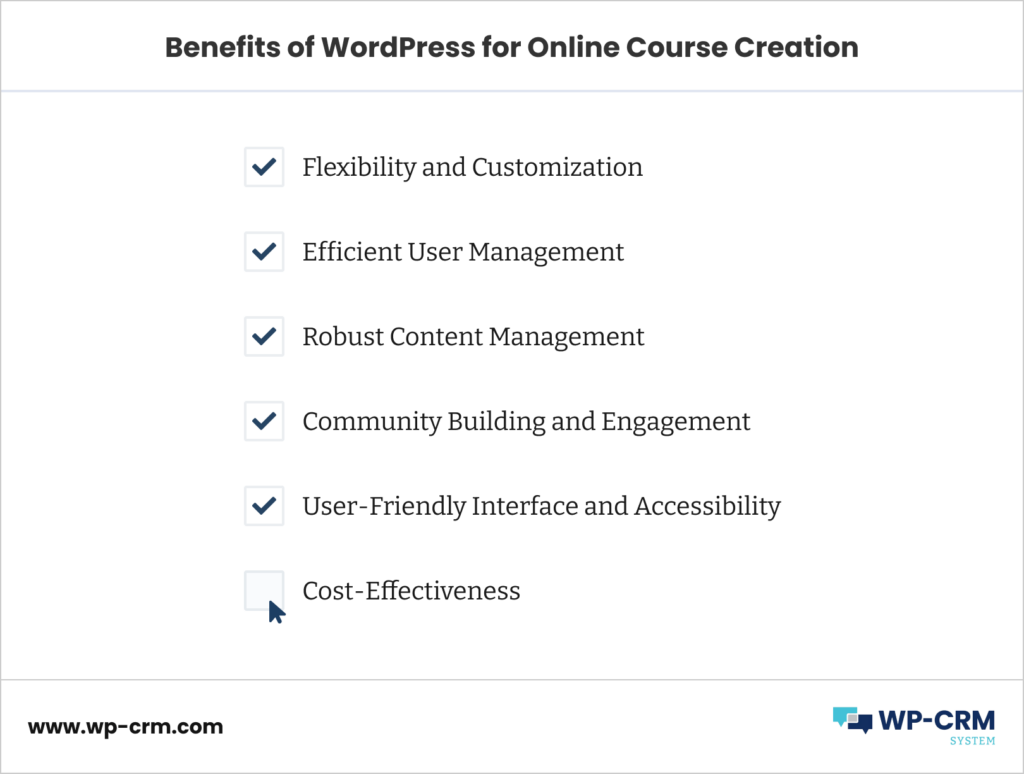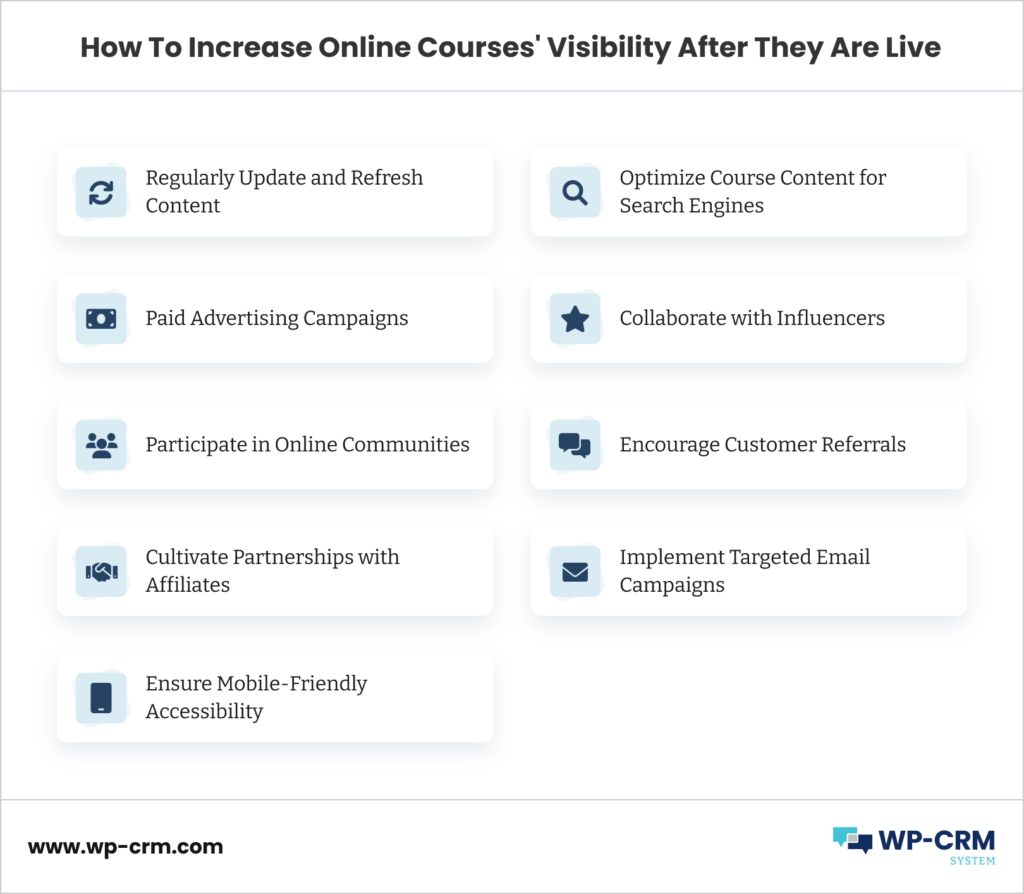How To Increase Online Courses’ Visibility
When it comes to online education, visibility is essential for success. In an era where the digital realm offers an abundance of educational opportunities, strategic visibility is the key to ensuring that valuable courses do not languish in obscurity.
The importance of a strategic approach to increasing visibility is underscored, setting the stage for a comprehensive exploration of the various dimensions involved in promoting and optimizing online courses.
In this article, we will explain how to go about planning your online course and highlight the benefits of using WordPress for it. Also, we will go through the necessary steps before and after you launch it to ensure its visibility and success.
Creating An Online Course That Sells: Where Do You Start?
Crafting an online course that captivates and sells begins with a profound understanding of your audience’s needs. By aligning course content with the expectations of the target audience, course creators set the stage for a compelling and successful online learning venture. Starting with a clear vision of your audience’s preferences ensures that your course not only meets their needs but also stands out in the competitive landscape of online education.
Benefits of WordPress for Online Course Creation

WordPress stands as an invaluable ally for educators entering the realm of online course creation, offering a suite of advantages that elevate the teaching and learning experience.
Flexibility and Customization
WordPress’s user-friendly interface and extensive plugin support grant educators unparalleled flexibility. The platform’s adaptability allows course creators to design and customize their online learning environment to suit diverse teaching styles and accommodate varied learner needs.
Efficient User Management
With streamlined user management features, WordPress empowers educators to effortlessly oversee student registrations, user roles, and access permissions. This efficient control enhances the ability to monitor individual progress, ensuring a tailored and personalized learning journey for each student.
Robust Content Management
WordPress’s robust content management system simplifies the organization and presentation of course materials. This feature enhances the overall user experience, facilitating intuitive navigation and engagement with educational content.
Community Building and Engagement
Beyond technical capabilities, WordPress fosters a sense of community through features like discussion forums and social sharing. These interactive elements contribute to a collaborative learning environment, boosting student engagement and retention.
User-Friendly Interface and Accessibility
WordPress’s user-friendly interface, coupled with widespread online support, makes it accessible to educators with varying technical expertise. The platform’s seamless updates ensure educators can stay current with technological advancements without disruption.
Cost-Effectiveness
In addition to its technical merits, WordPress proves cost-effective, eliminating licensing fees associated with other platforms. This affordability allows educators to allocate resources towards enhancing content quality and user engagement, making it a practical solution for those mindful of budget considerations.
How To Market Your Online Course Before It Is Live

Launching a successful online course requires more than just quality content; it demands a strategic and proactive approach to marketing. By generating buzz and building an audience before your course goes live, you lay the groundwork for a thriving educational venture. Here’s a comprehensive guide on how to effectively market your online course in the pre-launch phase:
Identify Your Target Audience
Before embarking on any marketing initiative, a profound understanding of your target audience is crucial. Define the demographics, preferences, and pain points of your ideal learners. This information serves as the foundation for tailoring your marketing messages and strategies to resonate with your audience.
Define Your Course’s Unique Selling Points (USPs)
Clearly articulate what sets your course apart from others in the market. Whether it’s a distinctive teaching style, exclusive content, or innovative delivery methods, highlight the aspects that make your course a must-attend for your target audience.
Market Research and Competitor Analysis
Investigate the demand for your course topic by conducting market research. Understand the pain points your audience seeks to address and tailor your course to meet those needs. Additionally, analyze competitor offerings to identify gaps in the market that your course can fill.
Design a Compelling Landing Page
Create a dedicated landing page for your course that serves as a virtual showcase. Clearly outline the benefits of your course, its unique features, and why prospective learners should enroll. Include compelling visuals, testimonials (if available), and a prominent call-to-action for visitors to express interest or sign up.
Leverage Social Media
Utilize the power of social media to create anticipation. Develop engaging teaser content, such as short videos, infographics, or behind-the-scenes glimpses, to showcase the value of your course. Encourage sharing and interaction to expand your reach organically.
Build an Email List
Start building an email list of potential learners who have expressed interest in your course. Offer a lead magnet, such as a free resource related to your course topic, to incentivize sign-ups. Regularly communicate updates, exclusive content, and pre-launch offers to keep your audience engaged.
Offer Pre-Launch Incentives
Entice early adopters by offering exclusive pre-launch incentives. This could include discounted course fees, additional resources, or early access to selected content. The goal is to reward those who express early interest and commitment.
Host Informative Webinars
Conduct webinars related to your course content to establish authority and engage with your audience. Use these sessions to address common questions, provide valuable insights, and showcase your expertise. Webinars create a sense of connection and anticipation among potential learners.
Encourage User-Generated Content
Encourage prospective learners to share their thoughts and expectations about your course on social media. User-generated content creates a buzz around your offering and serves as authentic testimonials, amplifying the positive perception of your course.
How To Increase Online Courses’ Visibility After They Are Live

Launching your online course is a milestone, but the journey to success continues post-launch. To ensure your course reaches its full potential, a strategic and multifaceted approach to visibility is essential. Here’s a detailed guide on how to enhance the visibility of your online courses after they go live:
Optimize Course Content for Search Engines
Implementing effective SEO strategies is paramount for improving online courses’ visibility on search engines. Conduct keyword research and integrate relevant keywords naturally into your course content. Craft compelling meta descriptions and titles to encourage click-throughs from search results.
Regularly Update and Refresh Content
Search engines favor fresh and updated content. Regularly revisit and update your course content to reflect the latest trends, insights, and industry developments. This not only boosts your search engine rankings but also demonstrates your commitment to providing up-to-date information.
Paid Advertising Campaigns
Supplement organic efforts with targeted paid advertising campaigns. Platforms like Google Ads and social media channels offer robust advertising options. Develop engaging ad creatives, define your target audience, and allocate a budget strategically to maximize visibility and reach.
Cultivate Partnerships with Affiliates
Engage in affiliate marketing by partnering with influencers or industry experts. Affiliates promote your course to their audience in exchange for a commission on sales. This collaborative approach leverages the existing reach of affiliates, expanding the visibility of your course to new and relevant audiences.
Implement Targeted Email Campaigns
Utilize your email list effectively to maintain engagement and visibility. Implement targeted email campaigns that share updates, exclusive content, and promotions. Leverage automation to personalize messages based on learner behavior and preferences, ensuring timely and relevant communication.
Collaborate with Influencers
Identify influencers in your niche and collaborate with them to promote your course. Influencers bring credibility and authenticity to your offering. Their endorsement can significantly enhance visibility, as their followers are more likely to trust recommendations from sources they already follow and admire.
Participate in Online Communities
Become an active participant in online forums, discussion groups, and communities related to your course topic. Share valuable insights, answer questions, and subtly promote your course when relevant. Building a presence in these communities establishes your expertise and introduces your course to potential learners.
Encourage Customer Referrals
Turn satisfied learners into advocates for your course. Implement a customer referral program that rewards existing learners for referring new participants. Word-of-mouth remains a powerful marketing tool, and incentivizing referrals can amplify the visibility of your course within your learners’ networks.
Ensure Mobile-Friendly Accessibility
In an era dominated by mobile usage, optimizing online courses for mobile accessibility is crucial. Ensure that your course platform and content are responsive and provide a seamless experience on various devices. Mobile optimization not only enhances user experience but also positively impacts search engine rankings.
Wrapping Up
In the dynamic landscape of online education, sustaining visibility is an ongoing effort. By consistently implementing SEO strategies, investing in paid advertising, cultivating affiliate partnerships, leveraging social media, utilizing email marketing, engaging in influencer marketing, participating in online communities, encouraging customer referrals, and optimizing for mobile accessibility, you fortify the visibility of your online courses. This multifaceted approach ensures that your courses remain prominently positioned, attracting and benefiting learners for the long term.
